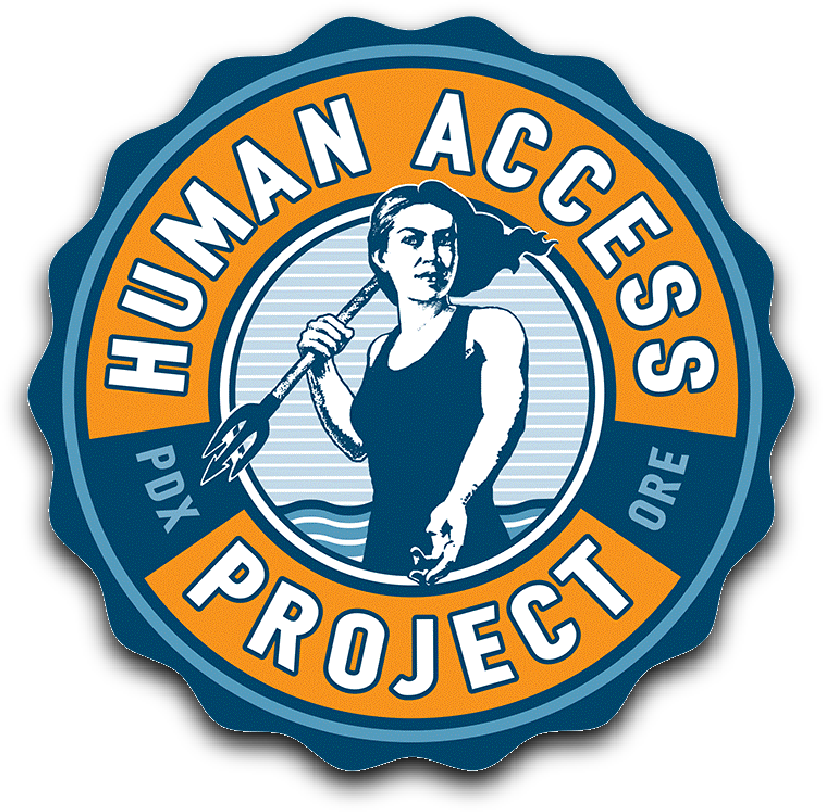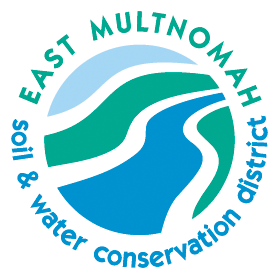Ross Island Lagoon HAB

SOLVING THE ROSS ISLAND LAGOON HARMFUL ALGAE BLOOM
Ross Island Lagoon suffers from a significant harmful cyanobacteria bloom (HCB, also referred to as hazardous algal bloom) which threatens water quality, juvenile salmon and the broader ecology of the lower Willamette River. The requested funding to reestablish river flow through the Ross Island Lagoon would address both the HCB and provide access to critical, robust, shallow water habitat inside the Lagoon.
Since 2017, Human Access Project has partnered with Oregon State University (OSU) to 1) lead analysis and design, and 2) support a diverse and engaged group of interested parties, towards identifying a feasible and effective solution for suppressing the Ross Island Lagoon. Through this process, constructing a flushing channel has emerged as the most promising and most sustainable long-term solution, but also involves the most complex modeling and design. The channel would be located on the upstream end of the lagoon to reintroduce flow to the lagoon, suppressing cyanobacteria growth by introducing cooler, more turbulent water.
A reestablished river flow through the Ross Island Lagoon would break up the stagnation that produces a significant harmful cyanobacteria bloom (HCB, also referred to as hazardous algal bloom) which threatens water quality, human health, juvenile salmon and the broader ecology of the lower Willamette River. This is a social justice issue. HCBs eliminate the ability for the river to be swimmable, fishable and drinkable, which disproportionately impacts lower income households.
The HCB in Ross Island Lagoon threatens environmental and human health. Manipulation of the lagoon over the last century has contributed to the HCB, which has been occurring with increasing frequency and intensity, and has led to the recent ODEQ listing of the lagoon as impaired for cyanobacteria.
WHY IS THIS HCB HAPPENING?
Ross Island was once two separate islands, the Willamette River flowed freely in-between. In 1926 the US Army Corps of Engineers constructed an embankment connecting the two islands to facilitate gravel extraction by Ross Island Sand and Gravel. The embankment cut off the natural downstream flow of the river, creating a stagnant Ross Island Lagoon. Over the years as excavation continued, the Ross Island Lagoon grew to its current condition - a massive (140 acre) stagnant pool with depths as great as 120’. Climate change has brought drier springs, hotter summers, and unpredictable snowpack, turning Ross Island Lagoon into a hyper productive HCB breeding ground. In recent years, HCBs incubated in the Ross Island Lagoon have occurred with greater frequency and intensity, leading to DEQ listing of the entire lower Willamette River as impaired for HCB.
HCB SALMON IMPACTS
Threatened juvenile salmon (winter steelhead and spring Chinook) migrate to the ocean through the lower Willamette River as they, but essential rearing habitats have all but disappeared as shallow, vegetated areas at the river’s edge were replaced by concrete walls and large rock. The RIL offers a rare remaining wild space in the lower river, including shallow water habitat young salmon need on their journey to the ocean.
However, prime rearing habitat inside the RIL is subject to poor water quality (high pH >9.5, elevated temperatures, and reduced food resources). Although there is considerable shallow water habitat inside the RIL, the current of the river, which young salmon rely on to move, does not currently enter the Ross Island Lagoon rendering this prime habitat nearly inaccessible and underutilized.
NEW UPLIFT TO SALMON AND WATER QUALITY
OSU research shows restoring river flow to the Ross Island Lagoon with a flushing channel will reduce water temperature, increase mixing (breaking up stagnation) and the level of HCB production which, in turn, will also lower the Ross Island Lagoon pH levels. Restored river flow from the mainstem Willamette River would naturally guide juvenile salmon to the Ross Island Lagoon's shallow water habitats. Mixing also favors beneficial algae growth (food source for salmon), such as diatoms and green algae, over the toxic and inedible HCB which are currently out-competing beneficial algae.
RACIAL EQUITY
The Willamette River is Portland’s second largest public space and natural area. The river naturally has a very low barrier of entry and easily allows access for people to connect with nature. HCBs take away this free, equitable, accessible public resource and disproportionately afflict poor black and brown working-class people. Many have no respite from the summer heat and there’s serious health risk contacting the water. These negative environmental impacts are a health and human rights issue when viewed through an environmental justice lens. For Indigenous peoples of the region, the Willamette River and Salmon (a First Food) are sacred. Indigenous people have a solemn obligation to protect the river and the wealth of natural resources it provides. Portland has the ninth largest Native American population in the US.
HEALTH & SAFETY
Multnomah County Health Department and Oregon Health Authority are issuing no contact health advisories at an increasing rate. August 2023 brought stunningly high concentrations of HCB toxins to the Willamette River. This past summer's bloom was the most extensive yet, with a toxic green river throughout downtown Portland and no-contact advisory extending from Sellwood to Kelly Point Park. HCBs can make humans sick. For dogs HCBs are lethal.
CLIMATE CHANGE IMPACTS
USGS data highlight how the river has warmed over time and how summer baseflows are getting lower and more persistent (staying low for longer). Lower and warmer baseflows amplify the intensity of HCBs. This problem will not go away without direct intervention.
Regarding resilience of the project to climate change, design of the flushing channel will be evaluated for a range of current and future flows, including the simulated depths of a range of future flood frequencies. OSU will rely on new 2D models developed by the U.S. Army Corp of Engineers to provide the river elevations where the flushing channel will connect to the Willamette. These modeled river elevations include estimated effects of climate-induced changes in upstream hydrology and will be used to design a channel that effectively flushes the Ross Island Lagoon and is stable under future peak flows.
Our work will use low-impact development practices and green infrastructure in project design and development. Reestablishing river flow through the Ross Island Lagoon with a flushing channel is a low carbon, natural solution to solving the HCB issue.
The primary effects of climate change on the Ross Island Lagoon involve:
-rising water temperatures from the basin upstream,
-rising winter peak flows,
-reductions in summer baseflows, and
-poorly understood projections of the distribution and abundance of salmon in the lower Willamette.
HOW DO WE SOLVE THIS?
Reestablishing river flow through the Ross Island Lagoon with a flushing channel is most sustainable and effective solution to solve this problem. Since 2017, OSU has explored myriad of alternatives, but all have major limitations. Reintroducing a natural flow through the Ross Island Lagoon with a flushing channel is the sole alternative that meets all criteria in OSU’s alternatives analysis: high expected effectiveness, minimal maintenance, minimal energy and carbon footprint, minimal in-river infrastructure, and increased ecological benefits (via access).
THE LOWDOWN ON WILLAMETTE RIVER HARMFUL ALGAE BLOOMS IN PORTLAND
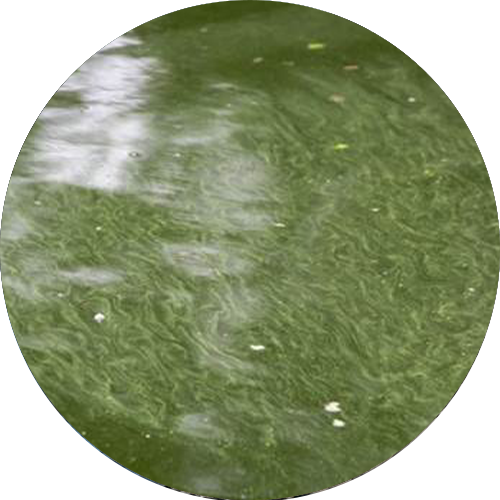
WHAT THE HECK IS A HCB?
- • A HCB is a Harmful Cyanobacteria Bloom (aka harmful algae bloom) that is not actually algae at all. HCBs are created by cyanobacteria, a photosynthetic, single-celled bacteria that naturally occur in fresh water and saltwater all over the world.
- • HCBs usually appear as thick, brightly colored scum – pea-green, blue-green, or brownish red.
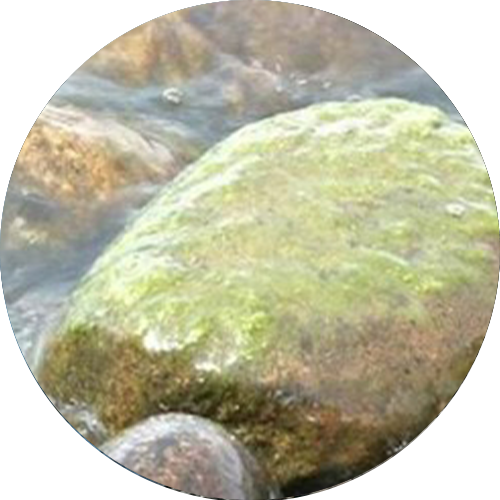
WHY SHOULD YOU CARE?
- • When testing shows acceptable cyanotoxin levels from a bloom, people can swim and recreate in the water. If toxin levels are too high, Oregon Health Authority will issue health advisories for affected areas.
- • As necessary, DEQ gathers data at Ross Island Lagoon and other areas on the Lower Willamette.
- • Climate change is creating conditions that favor cyanobacteria and the development of HCBs. Reduced snowpack, lower/warmer water levels, and less nutrient distribution equals more blooms.

WHAT TO DO
- • Avoid swallowing water in any natural waterway. If you do swallow water where you see a HCB, watch for symptoms similar to food poisoning, or tingling in fingers, toes, or around the lips.
- • All cyanobacteria can cause skin rashes, but cyanotoxins do not pass through the skin. Exposure occurs through swallowing affected water.
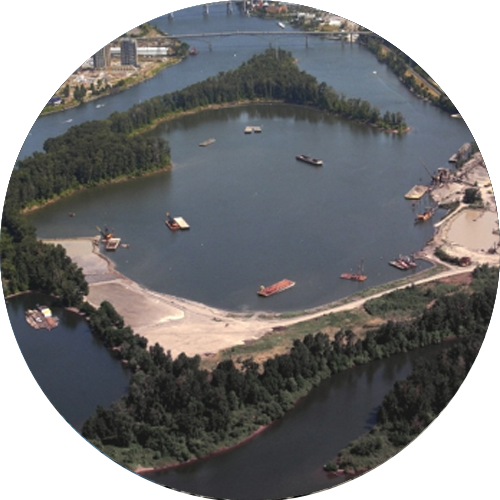
WHERE DO THEY OCCUR?
- • In the Lower Willamette River (LWR), HCBs typically form in warm, still water with minimal flow and high nutrient (nitrogen and phosphorous) concentrations. Cyanobacteria can multiply into large colonies called “blooms” that can produce cyanotoxins.
- • Ross Island Lagoon is essentially a pond within the Lower Willamette River with a favorable environment for cyanobacteria to multiply into a bloom. There are also other areas on the river where blooms can form.
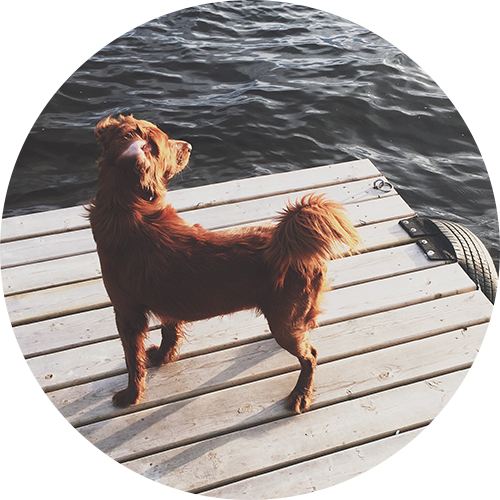
P.S. POOCH SAFETY
- • Cyanotoxins from a HCB can harm and even kill dogs. Don’t let your pet drink or swim in water with a HCB. If it happens, wash your pet with clean water and consult a vet.
- • For more information, go to www.healthoregon.org/hab
